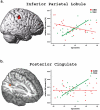ANS: aberrant neurodevelopment of the social cognition network in adolescents with autism spectrum disorders
- PMID: 21541322
- PMCID: PMC3082537
- DOI: 10.1371/journal.pone.0018905
ANS: aberrant neurodevelopment of the social cognition network in adolescents with autism spectrum disorders
Abstract
Background: Autism spectrum disorders (ASD) are characterized by aberrant neurodevelopment. Although the ASD brain undergoes precocious growth followed by decelerated maturation during early postnatal period of childhood, the neuroimaging approach has not been empirically applied to investigate how the ASD brain develops during adolescence.
Methodology/principal findings: We enrolled 25 male adolescents with high functioning ASD and 25 typically developing controls for voxel-based morphometric analysis of structural magnetic resonance image. Results indicate that there is an imbalance of regional gray matter volumes and concentrations along with no global brain enlargement in adolescents with high functioning ASD relative to controls. Notably, the right inferior parietal lobule, a role in social cognition, have a significant interaction of age by groups as indicated by absence of an age-related gain of regional gray matter volume and concentration for neurodevelopmental maturation during adolescence.
Conclusions/significance: The findings indicate the neural correlates of social cognition exhibits aberrant neurodevelopment during adolescence in ASD, which may cast some light on the brain growth dysregulation hypothesis. The period of abnormal brain growth during adolescence may be characteristic of ASD. Age effects must be taken into account while measures of structural neuroimaging have been clinically put forward as potential phenotypes for ASD.
Conflict of interest statement
Figures


References
-
- Bailey A, Phillips W, Rutter M. Autism: towards an integration of clinical, genetic, neuropsychological, and neurobiological perspectives. J Child Psychol Psychiatry. 1996;37:89–126. - PubMed
-
- WHO . Geneva: World Health Organization; 1994. International classification of diseases.
-
- Amaral DG, Schumann CM, Nordahl CW. Neuroanatomy of autism. Trends Neurosci. 2008;31:137–145. - PubMed
-
- Akshoomoff N, Pierce K, Courchesne E. The neurobiological basis of autism from a developmental perspective. Dev Psychopathol. 2002;14:613–634. - PubMed
-
- Karmiloff-Smith A. Development itself is the key to understanding developmental disorders. Trends Cogn Sci. 1998;2:389–398. - PubMed
Publication types
MeSH terms
LinkOut - more resources
Full Text Sources
Miscellaneous

